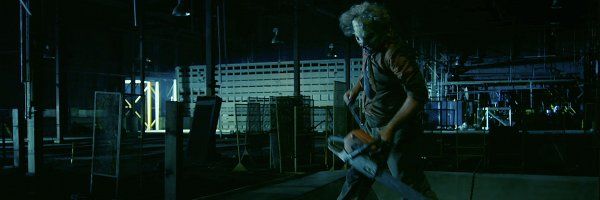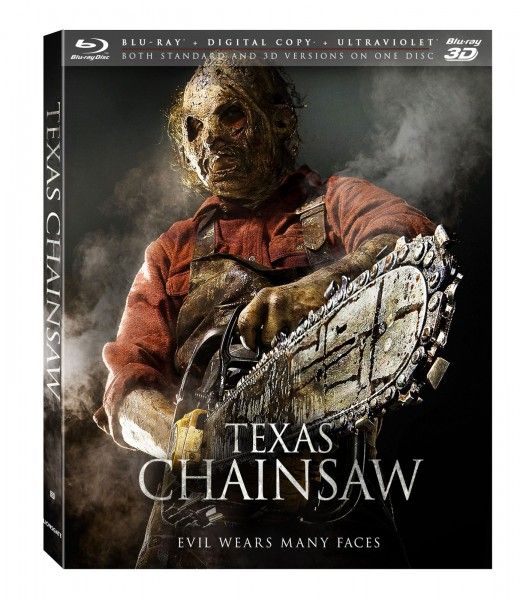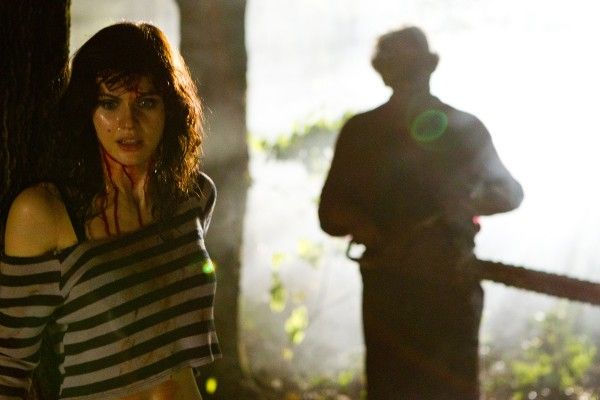There is no rational reason why I enjoy Texas Chainsaw as much as I do. It’s an unpretentious entry in a largely unremarkable horror franchise, which – like a lot of said franchises – followed its groundbreaking original up with an increasingly bewildering pile of drek. By now, no one expects anything from it, which may make its not-at-all-bad status come as a refreshing surprise. Hit the jump for my full review.
Its first positive step comes in cutting through the Gordian knot of sequels/prequels/remakes/reboots and getting back to basics. It basically ignores every entry that came after the first one, positioning itself as an immediate follow-up to the iconic Tobe Hooper original. Indeed, it starts up immediately after the first film ends, as the inevitable lynch mob shows up at that Texas homestead to burn the cannibal family out. Someone finds a baby in the ruins and spirits her off to a foster home, where she grows up to become a typically plucky horror movie heroine (Alexandra Daddario). Twenty years later, she gets a letter in the mail, having inherited a large estate from a relative she never knew. Piling a group of good buddies into a van, she sets out to take a look at her new homestead. You can probably guess where it all goes from there.
The path won’t earn any marks for originality, especially when the patented Lionsgate CG blood starts pouring in. But it does develop a surprisingly thoughtful subtext, which echoes some of the original film’s enduring potency. The leaders of that long-ago lynch mob have gone on to become respected members of the local community, ignoring their own bloodlust by foisting it onto Leatherface and his ilk. The monkeys outside the cage start to look an awful lot like the monkeys inside the cage as the movie goes on, reinforcing its sense of a universe where the laws we understand simply don’t apply.
With that as a basis, the film then goes about its expected hack-em-up formula with a lot of confidence. It won’t appeal to anyone but hard-core gorehounds, of course, but it throws a few twists into the mix that may catch a few of us unawares. The first time I saw it, I actually found myself leaning forward in my seat, genuinely interested in the outcome. It took me completely by surprise – January horror movies usually inspire an entirely different reaction – and that interest level holds up upon viewing the Blu-ray. (The 3D version, with its comin’-at-ya effects and delightfully cheeseball gimmicks, is ported over in this set for those with the proper equipment.)
Texas Chainsaw also carries numerous nods to the original, including cameos from Gunnar Hansen (the first Leatherface) and several other cast members who are clearly down with its vibes. That grants it further legitimacy against both its legions of critics and its fellow Chainsaw sequels (which by and large don’t acquit themselves one-tenth as well as this one does). Its appeal is limited, to be sure, and even horror fans may treat it with a dismissive shrug. But if you look a little harder, you may find something a little different in its shadows: something that makes it more than just another quickie cash in.
The Blu-ray does a terrific job of backing up the film’s dubious credentials. Besides a beautiful transfer – letting you catch every drop of that spattered blood – it contains a half-dozen insightful behind-the-scenes docs covering everything from the screenwriting process to casting the new Leatherface. There’s also a collection of on-set clips, an alternate opening, and the original trailer. The crowning achievement is a trio of great audio commentaries, including one featuring the cast of the original and another that pairs producer Carl Mazzocone with the legendary Hooper. As Blu-ray packages go, you could do a lot worse: a description that applies to the film itself as much as the set containing it.



